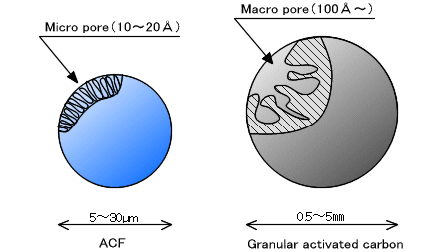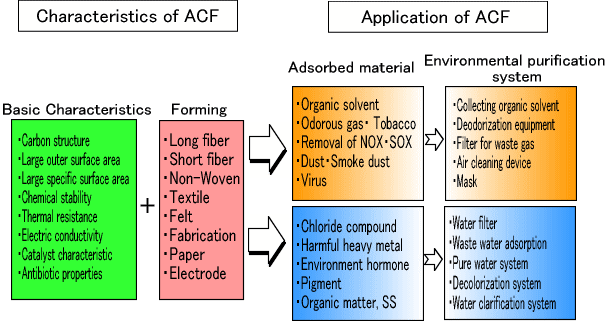| Activated CarbonFiber Environmental Purification Material |
What is Activated CarbonFiber?
|
Activated CarbonFiber (ACF) is fibriform activated carbon. ACF is made
of cellulosic, PAN, phenolic, and pitch fibers, and it is new advanced
material which is different from usual granular or powder activated carbon.
ACF's diameter is approximately 5 to 30 μm which is very fine compared
to granular activated carbon (grain diameter 500 to 5000 μm), and it has
larger surface area. Since ACF's pore diameter is apploximately 15 to 20Åand
most of pores are micro pores, the speed of adsorption and desorption is
fast. Moreover, it has excellent for adsorption in low concentration. ACF
doesn't fly apart like powder activated carbon(grain diameter 5 to 30 μm),
and it is easy to manufacture to various forms such as paper, textile,
and felt.
※1μm=10−6m =1/1000mm
※1Å=10−10m =1/10−7mm=0.1nm=100pm(Angstrom)
|
Comparison between ACF and Granular activated carbon
| |
ACF |
Granular activated carbon |
| Size |
Diameter 5 - 30 μm
Fiber form |
Grain diameter
0.5~5 mm |
Specific surface area
(㎡/g) |
700~2500 |
900~1200 |
Outer surface area
(㎡/g) |
0.2~2.0 |
~0.001 |
| Pore size (Å) |
Less that 20 |
- |
|

Pore of ACF and granular activated carbon |
Method for manufacturing ACF
|
 Manufacturing process Manufacturing process
The methods for manufacturing ACF differ depending on kinds of raw materials.
In general, the method is similar to manufacturing fibers for clothing.
Spun fibers are oxidized by heat treatment, and then they are activated
after conducting not to melt.
|

Example fo ACF manufacturing method |
 What is activation? What is activation?
Activation is reaction process to develop pore structure of CarbonFiber
material. By this
process, CarbonFiber is able to have fine pores. Thus, activation carries
out CarbonFiber
to have larger surface area and high functions such as absorption, compared
to usual carbide.
In the ways of activation, there are chemical activation method and
gas activation method.
In case of ACF, gas activation method is usual method to improve fiber
strength and purity.
|
|
 Material Material
Raw material of ACF is high quality PAN, PITCH based CarbonFiber material.
Thus, it is stable of quality and purity compared to activated carbon manufactured
by coconut shell and coal.
|
 Form of ACF Form of ACF
ACF can be various forms to bundles (tens of thousands filaments bundle),
cut fiber, yarn (twisted strings), textile, non-woven (felt). Moreover,
it can be used for honeycomb structure or cylindrical to make filters.
|
Characteristics of ACF
|
 Specific Surface Area of ACF Specific Surface Area of ACF
The diameter of ACF is 5 to 30μm and it has large outer surface area
which is contacting surface. Compared to granular activated carbon, the
area is 200 times larger. In addition, it has lots of fine pore which is
smaller than 20Å around the surface. Thus, its large surface area can effectively
function, and it has faster absorption-desorption speed as well as larger
adsorption capacity.
|
 Workability of ACF Workability of ACF
ACF is light and has flexible workability. Since its carbon fiber doesn't
spread out,
it is easy to change it form.
|
 Conductivity of ACF Conductivity of ACF
Since it is carbon material, its electric resistance is small so that
high conductivity. Its specific resistance value is approximately 10-1~10Ωcm. By using this electric characteristics, it is considered to use
ACF as condenser, lithium-ion battery, and electrode material.
|
ACF application to environment purification
|
Since ACF has large outside surface area and specific surface area, it
has greater adsorption ability. Due to this characteristics, it effectively
works for environment purification such as gas-phase treatment (exhaust
gas treatment) and liquid-phase treatment (water treatment).
|

Characteristics and Application of ACF
|
 Application to gas-phase treatment Application to gas-phase treatment
1. Collecting organic solvent
Since ACF is excellent for adsorption of low concentration gas and
has fast adsorption speed, it can function as an adsorbing material. It
is suitable for drycleaning, metal cleaning, and collecting organic solvent
such as trichloroethylene which is used to manufacture printed board, IC
related to electronics.
2. Removal of odorous gas and cigarette smoke
Because ACF can absorb Ammonia and sulfide which are the source of
bad odor quickly, it is suitable for deodorant filter.
3. Removal of NOx・SOx
ACF enables to conduct adsorption removal of low level of NOx and SOx
which are contained in waste gas or the air. Thus, it is suitable for catalyser
of waste gas or denitration systems.
※For gas-phase, since ACF enables to protect from germ such as novel
influenza, ACF is used for masks. The mask has an effect on prevention
of infectious disease. In addition, fine dust and powder dust are also
absorbed by ACF, so that ACF masks can work for anti-pollen ora anti-dust.
It can be also used at disaster sites.
|
 Application to Liquid-phase treatment Application to Liquid-phase treatment
1. Removal of chloride compound
It can be used as water filter since ACF can remove chloride compound
such as trihalomethane which is contained in tap water. ACF doesn't fly
apart nor isn't damaged by pressure, so it tend not to suppress the speed
of passing water.
2. Removal of harmful heavy metal ions
ACF enables to remove harmful heavy metal ions which are contained
in waste water or source of drinking water. With regard to waste water
treatment, it is suitable to remove harmful matters which are not be removed
by biological treatment nor coagulation settling treatment. Moreover, it
can remove harmful heavy metal such as cadmium, lead, aresevic, and manganese
which are eluted from mines.
3. Removal of pigment
Pigment waste water which are not treated by coagulation settling treatment
can enable to be removed by ACF.
※For liquid-phase, microorganisms quickly attach to ACF since ACF has
small electric resistance. Moreover, because it is based on carbon, it
has high bioaffinity. Thus, it is suitable for carrier for biological treatment
or electrode for microbial fuel cell.
|
Activated CarbonFiber Environmental Purification Material
|
 Activated Carbon Fiber Non-Woven Fabric Activated Carbon Fiber Non-Woven Fabric
ACF is processed as non-woven fabric. Due to its large outer surface
area and specific surface area, it can absorb various matters.
MiraCarbon ACFNW-EM 1(t=1mm)
MiraCarbon ACFNW-EM 2(t=2mm)
MiraCarbon ACFNW-EM 3(t=3mm)
MiraCarbon ACFNW-EM 4(t=4mm)
MiraCarbon ACFNW-EM 5(t=5mm)
Information for Activated CarbonFiber non-woven fabric products
|
関連製品
|
 Activated Carbon Granular Non-Woven Fabric Activated Carbon Granular Non-Woven Fabric
|
 Activated Carbon Powder Non-Woven Fabric Activated Carbon Powder Non-Woven Fabric
|
 Activated CarbonFiber mask Activated CarbonFiber mask
|

